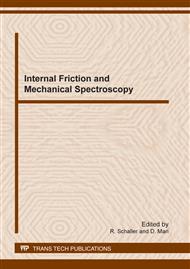p.75
p.81
p.87
p.92
p.98
p.104
p.110
p.116
p.122
Oxygen Vacancy Relaxation in Ca3Co4O9+δ Ceramics
Abstract:
Ca3Co4O9+δ ceramic powders were synthesized by the polymerized complex (PC) method. The same Ca3Co4O9+δ ceramic bar were treated in turn with three different processes of oxygen treatment: with no treatment, with oxydol (H2O2) treatment, and with N2 treatment. Dynamic mechanical analysis (DMA) was performed from 123 to 623 K at rate of 1 K/min while the measuring frequencies are 0.05, 0.1, 0.25, 0.5, 1, 2, and 5 Hz. Two internal friction peaks are observed: one at the temperature range from 360 to 400 K (a broad peak, peak 1) and the other at around 390 K (a sharp peak, peak 2). Peak 2 is in correspondence with sudden metal-semiconductor transition (MST) near 400 K. Peak 1 is a kind of internal friction relaxation peak. For the sample with H2O2 treatment and with no treatment, the activation energy H are 1.24 eV and 1.04 eV, respectively, and the preexponential factor τ0 are 2.54×10-17 sec and 7.82×10-15 sec, respectively. We speculate that the mechanical relaxation process occurs in the Ca2CoO3 subsystem of Ca3Co4O9+δ. The relaxation process for sample with no treatment is associated with the migration of OVs clusters in Ca2CoO3 subsystem, and the relaxation process for the sample with H2O2 treatment is associated with the migration of isolated OVs in Ca2CoO3 subsystem.
Info:
Periodical:
Pages:
98-103
Citation:
Online since:
January 2012
Authors:
Price:
Сopyright:
© 2012 Trans Tech Publications Ltd. All Rights Reserved
Share:
Citation:


